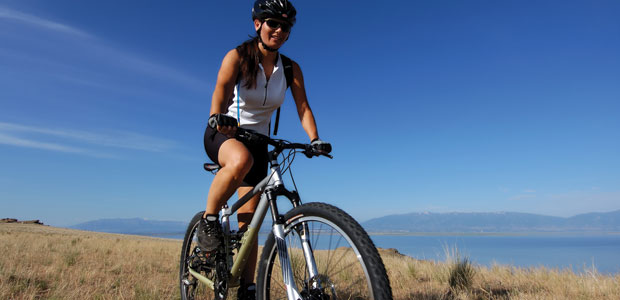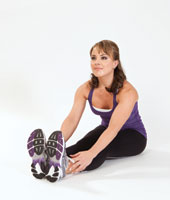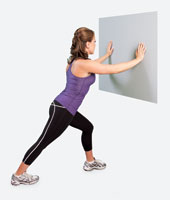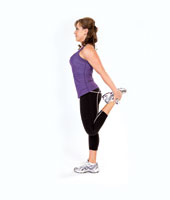
Get ready to hit the road with our biking exercises. Cycling benefits your lower body most. It works out the quadriceps, calves, hamstrings, and butt.
The sights, sounds, and smells that come alive on a bike trip are unlike anything that can be experienced from the comfort of a car: quaint farmhouses and artisans’ shops, lambs bleating as they frolic in roadside pastures, the smell of cedar trees after a dash of warm spring rain.
To get riding, you need the right gear. The following guide will help you decide which bike is most suited to your cycling needs and choose a bike that is properly fitted to your size and comfort needs.
Types of bicycles
Mountain bikes refer to a broad category of bicycle used for off-road purposes—including cross-country, downhill, and freeride bikes. By nature, mountain bikes are extremely durable, and they utilize wide handlebars and wide-gauge tires with exaggerated treads for negotiating obstacles.
Moreover, many brands have suspension systems that help to absorb the shock of riding across rough surfaces. They also feature wide-ranging gears—typically from low to mid ratios—which are ideal for precision manoeuvring on technically difficult terrain.
Road bikes (aka racing bicycles) are built for speed and have frames that are composed of lightweight materials and a stripped-down arsenal of accessories. The curved “drop” handlebars permit a bent-over riding position, which, when combined with narrow high-pressure tires, make for a frictionless and aerodynamic ride. The gear range for racing bicycles tends to be narrow and weighted toward medium to high ratios, allowing cyclists to fine-tune their pedalling cadence for maximum efficiency.
Touring bikes are ideal for long-distance riders who will be on the road for multiple days. Their design emphasizes comfort and durability, and they usually have the capacity to transport baggage. A wide and flexible gear range also allows cyclists to adapt to changing conditions on a longer journey.
Hybrid bikes are for the more general cyclist. They seek to blend the best characteristics of mountain bikes (stouter frame and wider tires for better traction and stability) and road bikes (lighter components and taller gearing for going faster) into a single design that is comfortable, durable, and speedy. They are designed for use on both streets and unpaved bike paths.
Fitting and size considerations
The first thing you should check before purchasing a bicycle is the height. When you straddle it, there should be about 3 to 5 cm between your crotch and the upper bar of the frame (a mountain bike should have about 5 to 7 cm). You should also be able to set the bicycle seat high enough so that your legs straighten almost entirely during the lowest part of the pedal rotation—which will increase your power and minimize your fatigue.
When testing a bike seat, make sure that your weight is being supported by the same spots on your posterior as when you’re sitting upright on a flat surface. The seat should be level to maximize comfort and pedalling efficiency.
Adjusting your handlebars may require some fine-tuning, as your cycling goals and body type will dictate what is most comfortable. As a rule of thumb, the handlebars on a road bike should be 3 to 5 cm lower than the top of your seat; handlebars on a mountain bike may be as much as 7 to 10 cm lower than the seat, which provides off-trail riders with a lower centre of gravity. This helps to distribute weight across both wheels when negotiating rugged terrain.
However, if comfort is your primary concern, adjust the handlebars so they’re raised 3 to 5 cm above the level of your seat. You’ll ride in a more upright position, meaning that more of your weight will be borne on your rear rather than on your back, shoulders, and wrists.
Health benefits of biking
Although cycling benefits your lower body the most—giving your quadriceps, calves, hamstrings, and butt an intense workout—you may be surprised to learn that it can also strengthen your back and upper body at the same time.
The cyclic movement of your legs is great for working your lower back muscles, which in turn develops the small muscles that support your individual vertebra and can help prevent back pain and slipped discs. Furthermore, if your body is positioned to lean forward while pedalling, your shoulders and arms are strengthened by supporting your upper body.
Cycling is also known to increase your bone density, and because the bike frame acts to support your body, it has a lower impact on your joints than sports that involve running. The circular motion of cycling actually helps to build and maintain cartilage in your knees, whereas running can damage this same cartilage.
Finally, even moderate cycling can be a great cardiovascular workout that will strengthen your heart and respiratory system while at the same time lower blood pressure and reduce harmful cholesterol. This reduces the risk of numerous ailments, especially heart- and lung-related maladies.
Exercises for getting bike ready
Before you dust off that rusty two-wheeler and hop on, consider the following pre-biking exercises.
Get stationary
Not surprisingly, the best preparation is to ride a stationary bike two orthree times a week for an hour, which works those exact same muscles.
Pump iron
For serious people who want to take biking to the next level, consider a weight-training program that emphasizes the key muscle groups in your legs and lower back. Sprint cyclists should focus on lifting heavier weights with lower repetition, while endurance cyclists should use lighter weights with greater repetition.
Stretch it out
One disadvantage of cycling is that your leg muscles don’t go through a full range of motion, which means that over a period of time your leg muscles can lose some of their elasticity—particularly the hamstrings. One way to avoid this is to do a few simple stretching exercises right after cycling, focusing on your hamstrings, quadriceps, and calves.
|
Hamstring stretch
|
 |
 |
Calf stretch
|
|
Quad stretch
|
 |



































